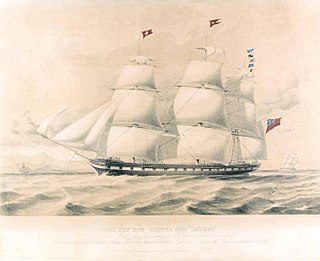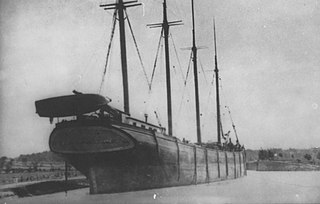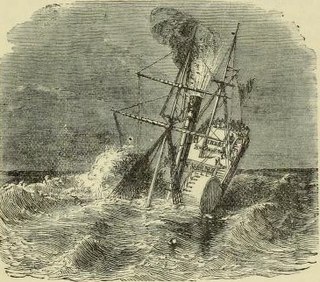This article needs additional citations for verification .(April 2011) |


PS Queen Victoria was a paddle steamer built for the City of Dublin Steam Packet Company in 1838 and wrecked in 1853 with the loss of more than 80 passengers and crew.
This article needs additional citations for verification .(April 2011) |


PS Queen Victoria was a paddle steamer built for the City of Dublin Steam Packet Company in 1838 and wrecked in 1853 with the loss of more than 80 passengers and crew.
Queen Victoria was built by Wilson shipbuilders of Glasgow, Scotland in 1838 for The City Of Dublin Steam Packet Company. She had a wooden hull, was 150 feet long and was powered by a two-cylinder steam engine.
The Queen Victoria left Liverpool on the night of 14 February 1853 with cargo and approximately 100 passengers. As it approached the Irish coast at Howth it was hit by a snowstorm. It struck Howth Head around 2:00am on 15 February. The Captain backed the ship away from the Head in hopes of being able to navigate into the harbour. The damage to the ship was more extensive than the captain thought and it quickly began to fill with water. It drifted, dead in the water, and struck below the Baily Lighthouse. It sank within 15 minutes of the second hit, 100 yards south of the lighthouse. Approximately 83 passengers and crew perished, including the Captain. One lifeboat, with 17 passengers, made it to shore. [1]
A Board of Trade inquiry blamed the ship's captain and first officer, as well as the lighthouse crew. A fog bell was supposed to have been installed in the lighthouse in 1846, seven years earlier, but was delayed due to costs of other construction projects. The bell was finally installed in April 1853, as a result of the Queen Victoria shipwreck and the subsequent inquiry.
At least one attempt to raise the ship was made afterwards, which failed, and the ship was salvaged where she lay. The wreck is still in place.
Members of the Marlin Sun Aqua Club, Dublin discovered the wreck in 1983. They reported their discovery to the authorities, and were in part responsible for having the first Underwater Preservation Order placed on a shipwreck in Irish waters. They also carried out the first underwater survey on such a wreck. The wreck was the first to be protected by The National Monuments Act (Historic Wreck), when the order was granted in 1984, thanks to representations made by Kevin Crothers, IUART, and the Maritime Institute of Ireland. [2]

HMS Birkenhead, also referred to as HM Troopship Birkenhead or Steam Frigate Birkenhead, was one of the first iron-hulled ships built for the Royal Navy. She was designed as a steam frigate, but was converted to a troopship before being commissioned.

RMS Tayleur was a full-rigged iron clipper ship chartered by the White Star Line. She was large, fast and technically advanced. She ran aground off Lambay Island and sank, on her maiden voyage, in 1854. Of more than 650 aboard, only 280 survived. She has been described as "the first Titanic".

The steamship, SS Thames, was built in 1827 by Fletcher's in Limehouse, London, and belonged to the City of Dublin Steam Packet Company. She was commanded by Captain James Grey and wrecked on the Western Rocks, Isles of Scilly early on the morning of 4 January 1841 on her way from Dublin to London.

The Baily Lighthouse is a lighthouse on the southeastern part of Howth Head in County Dublin, Ireland. It is maintained by the Commissioners of Irish Lights.

Forfarshire was a paddle steamer with brigantine rigging, built in Dundee in 1834, and which struck and later foundered on one of the Farne Islands on 7 September 1838, giving rise to the rescue for which Grace Darling is famed.

The City of Dublin Steam Packet Company was a shipping line established in 1823. It served cross-channel routes between Britain and Ireland for over a century. For 70 of those years it transported the mail. It was 'wound-up' by a select committee of the House of Lords in 1922 and finally liquidated in 1930.
Events from the year 1853 in Ireland.

SS Sirius was a wooden-hulled sidewheel steamship built in 1837 by Robert Menzies & Sons of Leith, Scotland for the London-Cork route operated by the Saint George Steam Packet Company. The next year, she opened transatlantic steam passenger service when she was chartered for two voyages by the British and American Steam Navigation Company. By arriving in New York a day ahead of the Great Western, she is usually listed as the first holder of the Blue Riband, although the term was not used until decades later.

PS Portland was a large side-wheel paddle steamer, an ocean-going steamship with side-mounted paddlewheels. She was built in 1889 for passenger service between Boston, Massachusetts, and Portland, Maine. She is best known as the namesake of the infamous Portland Gale of 1898, a massive blizzard that struck coastal New England, claiming the lives of over 400 people and more than 150 vessels.

SS President was a British passenger liner that was the largest ship in the world when she was commissioned in 1840, and the first steamship to founder on the transatlantic run when she was lost at sea with all 136 onboard in March 1841. She was the largest passenger ship in the world from 1840 to 1841. The ship's owner, the British and American Steam Navigation Company, collapsed as a result of the disappearance.
The SS Ava was a 1,613 GRT British steamship, constructed in 1855 by the Tod & McGregor shipyard in Glasgow. Described as "an iron screw barque with one funnel", she was operated by the Peninsular & Oriental Steam Navigation Company on the China mail service and was named after Ava, the ancient capital of Burma. She ran aground and was wrecked off the coast of Ceylon in February 1858.

SS (RMS) Queen of the Isle was a paddle steamer which was constructed by Robert Napier & Co. Glasgow. No Official number is recorded for the vessel, as formal registration was not introduced until the Merchant Shipping Act 1854.

SS Empress Queen was a steel-hulled paddle steamer, the last of her type ordered by the Isle of Man Steam Packet Company. The Admiralty chartered her in 1915 as a troop ship a role in which she saw service until she ran aground off Bembridge, Isle of Wight, England in 1916 and was subsequently abandoned.

SS (RMS) Mona's Isle (III), No. 76304, the third ship in the company's history to be so named, was a paddle steamer which served with the Isle of Man Steam Packet Company until she was purchased by The Admiralty in 1915.

The SS Nile was an iron-hulled cargo steamship. She is best remembered for her sinking in bad weather on 30 November 1854 with the loss of all hands, most likely after colliding with The Stones, a notoriously dangerous reef off Godrevy Head in Cornwall.

Minnedosa was a four-masted wooden Great Lakes schooner launched in 1890. This was late in the era of sailing ships and it spent its career as a schooner barge, towed by a steam tug. It was lost with its nine crew and passengers and a heavy load of grain in a storm October 20, 1905 on Lake Huron.
HMS Prospero was a wood-hulled British paddle steamer built in 1829 on the River Clyde at Port Glasgow as Belfast for service between Glasgow and Belfast. In 1837 she was purchased by the Admiralty to run as HMS Prospero on the packet service between Pembroke and Ireland. She was broken up in 1866.

PS Pegasus, was a sea-going paddle steamer launched in Glasgow, Scotland, in December 1836. The ship was owned by the Hull & Leith Steam Packet Company, working a route between the two ports of Hull and Leith on a weekly basis. She sank after striking a rock on 20 July, close to the Farne Islands.